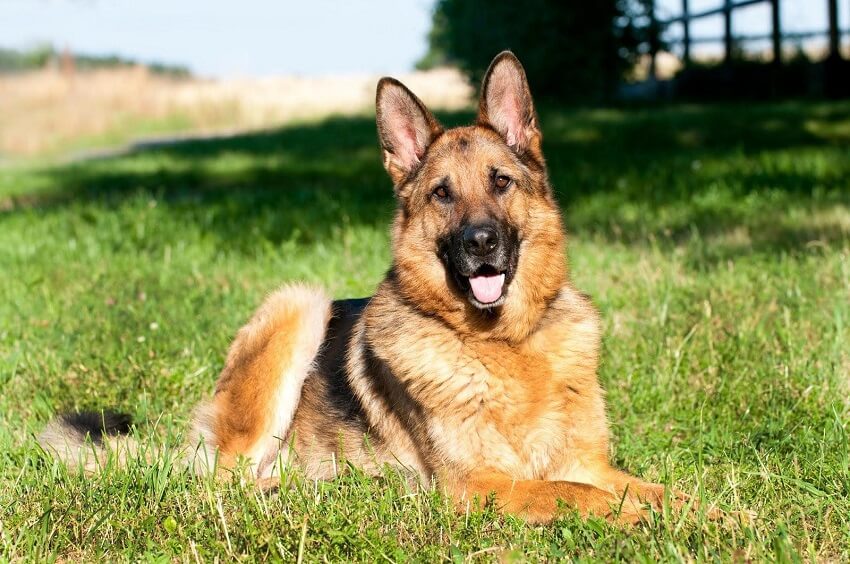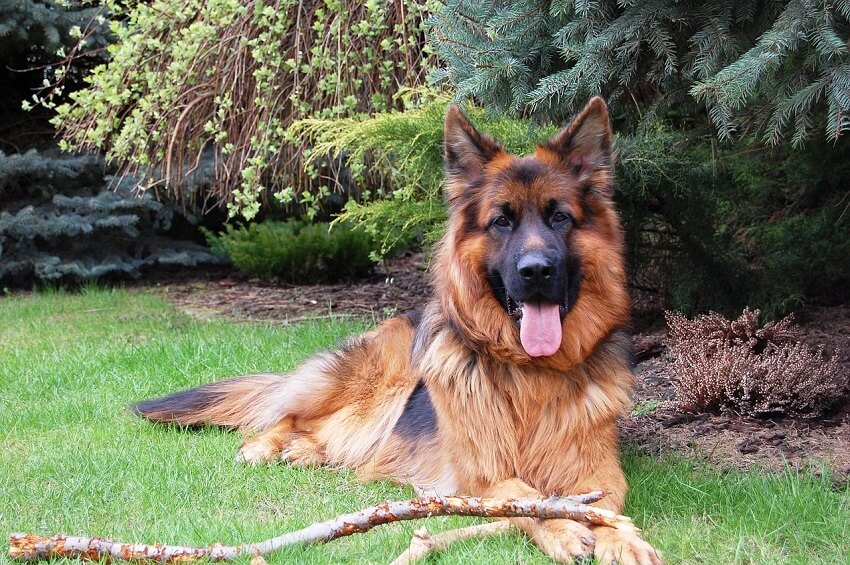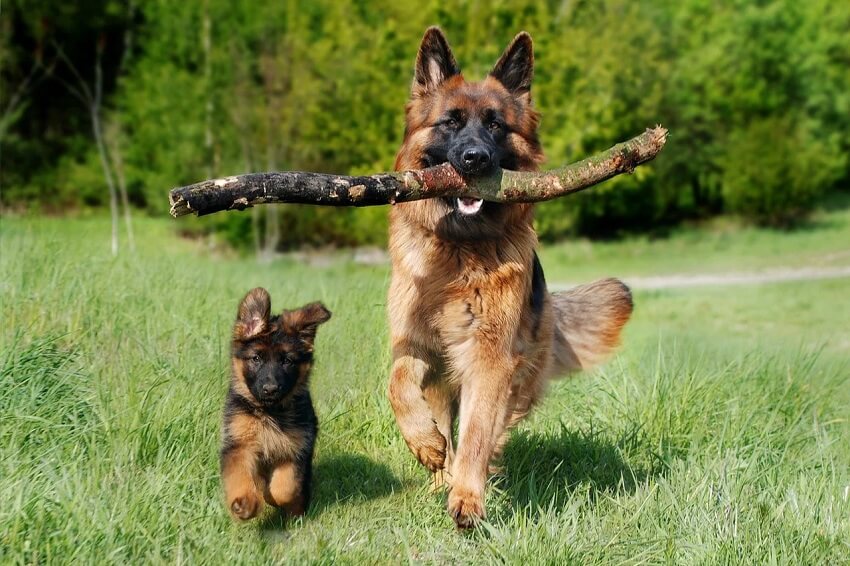The German Shepherd Dog (GSD) is a highly favored companion dog breed worldwide. German Shepherds possess characteristics that make them intelligent, strong, and effective as both pets and guard dogs. Experienced owners often excel at raising German Shepherds. However, for those new to the breed who are considering owning a GSD, Know All Animals invites you to explore the following article for guidance on proper care and training.
1. Understanding the German Shepherd Breed
The German Shepherd is a beloved breed originating from Germany. Below is information about its origins and the distinct characteristics of its appearance and temperament:
1.1. Origin of the German Shepherd Dog
The German Shepherd, also known as the GSD, is a breed originally developed for herding livestock. Over time, this breed has been utilized for various purposes, including search and rescue, national defense and security roles, assisting people with disabilities, serving as guard dogs, and being loyal companions.
In the 19th century, German breeders crossed native dog breeds to create herding dogs for farming and agricultural work. Max von Stephanitz, a former cavalry captain and veterinary student from Berlin, particularly valued the intelligence, strength, and working ability of these dogs, but he had yet to find a breed that met his perfect standards.
In 1899, at a dog show, Stephanitz encountered Hektor Linksrhein, a selectively bred dog with outstanding intelligence, strength, loyalty, and beauty, and was greatly impressed. He purchased Hektor, renamed him Horand von Grafrath, and founded the German Shepherd Dog Club. Horand was chosen as the primary stud dog for breeding, leading to the development of the famous German Shepherd breed we know today.

1.2. Physical and Temperamental Characteristics of the German Shepherd Dog
German Shepherds are large dogs. Males typically stand 60–65 cm (23.5–25.5 inches) tall and weigh approximately 30–40 kg (66–88 lbs), while females are generally more compact, with a height of 55–60 cm (21.5–23.5 inches) and a weight of 22–32 kg (48.5–70.5 lbs). This breed has a thick coat, primarily black and tan, though solid black or sable colors also exist.
They possess a domed forehead, a long, square muzzle with strong jaws, a sensitive black nose, and large, erect ears. German Shepherds can run up to 40–50 km/h (25–31 mph) and possess exceptional stamina.
In Stanley Coren’s list of dog breeds with the best working ability and obedience, the German Shepherd is ranked second, indicating their high intelligence, obedience, and ability to quickly memorize many commands. German Shepherds are extremely loyal to their owners, always vigilant, and ready to protect their owners when they sense danger.
German Shepherds are an incredibly loyal breed. This breed is particularly intelligent, capable of learning training exercises quickly and accurately. German Shepherds can distinguish human moods; they know when you are happy and when you are sad. GSDs are very friendly and approachable, they play happily with other animals. Notably, German Shepherds are very fond of and play with small children very carefully.
2. Distinguishing Popular German Shepherd Breeds
Many dog owners in Vietnam often confuse the German Shepherd Dog and the Belgian Malinois. Despite having similar names in Vietnam and many resemblances in appearance, temperament, and purpose, these are, in fact, two entirely different dog breeds.
- German Shepherd Dog (GSD): Originating from Germany as a herding dog, the German Shepherd possesses a powerful, muscular body and a thick coat. They are noted for their superior endurance, intelligent, courageous, and calm demeanor. German Shepherds are commonly used as guard or protection dogs due to their high alertness.
- Belgian Malinois: While also a herding dog, the Malinois originates from Belgium and has distinct differences. They have a tall build, comparable to German Shepherds, but a more compact and agile appearance thanks to their short, close-fitting coat. This breed is highly intelligent, perceptive, and loyal, yet they are also very energetic and can be easily distracted during training. Belgian Malinois are often chosen for search and detection tasks.
Thus, although they share many similarities, the German Shepherd Dog and the Belgian Malinois have different characteristics and applications, making an accurate distinction between them very important.

3. Should You Choose to Own a German Shepherd Dog?
Deciding whether or not to own a German Shepherd Dog depends on your personal preferences, lifestyle, and living conditions. Here are the prominent advantages of this breed that you should consider:
- Intelligent and Perceptive: German Shepherds learn quickly and can remember many commands, making them very easy to train without requiring excessive effort or time for instruction.
- Loyal and Devoted to Family: GSDs are loyal, obedient dogs that protect their owners. They are calm yet also very playful, showing affection and bonding closely with their human companions.
- Highly Alert: Beyond being companion animals, German Shepherds, with their high alertness, are an ideal choice for protecting your home, property, and family’s safety.
- Good Adaptability: Although GSDs are large dogs, they can adapt to various living conditions, from urban environments to rural areas, as long as they are provided with sufficient space and care.
However, owning a German Shepherd also requires careful consideration if your home doesn’t have enough space or if you lack the time to provide the necessary exercise for this active breed. German Shepherds also need to be trained from a young age to prevent undesirable behaviors, which demands experience and firmness in raising your pet.
4. How to Care for and Train German Shepherds
German Shepherds are relatively easy to care for but require early training. Here’s how you can raise and train your German Shepherd:
4.1. German Shepherd Nutrition
A German Shepherd’s diet needs to be well-balanced with sufficient nutrients like fiber, fats, vitamins, and carbohydrates to ensure their overall development. Providing a nutritious and scientific diet will help your GSD grow quickly, stay healthy, resist illnesses, and fully utilize their strengths to protect people.
German Shepherd Feeding Schedule by Age:
- 2 to 3-Month-Old Puppies: At 2 months old, GSD puppies are weaned and can start eating soft food and begin basic training. During this period, feed your GSD multiple small meals a day (morning, noon, afternoon, evening) with even spacing. The food quantity should be moderate, around 200g per meal, plus 0.5L of milk daily. You can also give them two fertilized duck eggs per week, but no more, as they are very rich. Ensure food is soft, cooked, and not cold or raw, as their digestive system is still very sensitive. When first house-training your GSD puppy, be firm to establish the habit. If you have time, take your puppy for walks, exercise, and play, as GSD puppies tend to be quite lazy and sleepy at this age.
- 3 to 5-Month-Old Puppies: At this stage, you should increase their food portions as German Shepherds grow larger. Specifically, reduce meals to 3 times a day, with food portions increasing to 400-500g and 1L of milk daily. Give them one chicken egg every other day to provide protein. At this age, GSDs are more active, so you shouldn’t keep them confined indoors. Take your GSD for walks, outings, and practice basic training exercises that develop muscles and intellect, such as fetching discs or finding objects. Maintain this exercise and feeding regimen until they reach 5 months old.
- 5 to 6-Month-Old Puppies: This is a slightly more challenging phase as your puppy enters a period of rapid growth. The feeding schedule remains 3 meals a day, but the food portion increases to 600g per meal. Focus on adding plenty of protein, including more meat and eggs. GSDs at this age also need a lot of exercise, so ensure they receive enough nutrients to maintain energy for their training.
- Over 6-Month-Old German Shepherds: At this point, your GSD is ready for an adult feeding and exercise regimen. German Shepherds are encouraged to eat more meat and engage in high-intensity activities. Increase their food intake to 800-900g per meal, 3 times a day. During this stage, it’s crucial to ensure they receive sufficient nutrients for overall development and health.
4.2. Body Hygiene and Exercise Stimulation
German Shepherds require regular bathing and coat care to keep them clean and minimize the risk of skin diseases. You can bathe your GSD approximately 2–4 times a month, especially after they’ve been running and playing outdoors. Additionally, cleaning their ears, trimming their nails, and brushing their teeth are also very important.
German Shepherds need a spacious environment for living and exercising because they are full of energy. Activities like jogging, playing fetch, and daily walks are essential for maintaining your pet’s health. If you keep your dog in a cramped living space, you must take them outside frequently to help them release energy and prevent mental issues.
4.3. How to Train German Shepherds
German Shepherd training should begin when the dog is 2–3 months old, starting with basic commands such as sit, lie down, stay, etc. Owners with specialized dog training expertise can teach German Shepherds to perform advanced tasks like protection, object retrieval, or danger detection.

5. Common Health Issues in German Shepherds
The average lifespan of a German Shepherd Dog is 7–10 years. Although they are a healthy and active breed, German Shepherds are prone to certain health conditions, including:
- Allergies and Skin Conditions: As an active breed that enjoys running and playing outdoors, German Shepherds can easily contract fungal infections, ticks, and fleas, causing itchiness and skin damage.
- Degenerative Joint Disease: German Shepherds are susceptible to hip dysplasia and elbow dysplasia, which can lead to degenerative joint disease, causing difficulty in movement and a risk of paralysis if not treated promptly.
- Heart Disease: GSDs are at risk of developing heart problems, particularly dilated cardiomyopathy, which affects the heart’s ability to pump blood and impacts overall health.
- Hypothyroidism: Some German Shepherds may have an underactive thyroid gland, which can make them feel tired, less active, and lead to abnormal weight gain.
6. How Much Does a German Shepherd Cost?
The German Shepherd Dog (GSD) is one of the most intelligent, loyal, and popular dog breeds in Vietnam. The selling price for this breed can vary significantly depending on age, origin, documentation, and training level. Specifically:
6.1. Price of German Shepherd Puppies (2–4 months old):
- $115–$230 USD: Puppies without papers, born in Vietnam, average quality.
- $230–$345 USD: Vaccinated, good health, decent appearance, no VKA papers yet.
- $345–$575 USD: Purebred GSDs, with VKA papers, standard appearance, good lineage.
- $575–$765 USD: High-quality dogs with complete documentation, beautiful appearance, excellent health, suitable for breeding.
6.2. Price of Adult German Shepherds (over 4 months old):
- $190–$305 USD: Basic GSDs, untrained, no papers.
- $305–$535 USD: Purebred dogs, suitable for breeding, stable health.
- $575–$765 USD: Basic obedience trained, imported parents, fully vaccinated.
- $765–$1,150 USD: Imported from Thailand or South Korea, complete documentation, well-trained.
- Over $1,900 USD: Imported from Europe (Germany, Russia, USA), high-grade purebred, suitable for breeding or competitions.
6.3. Price of Mixed-Breed German Shepherds:
- $38–$115 USD: GSDs mixed with local dogs or other breeds like Husky, Phu Quoc. Affordable, easy to care for, suitable as basic pets.

Although German Shepherds have excellent physique, you still need to ensure they receive full vaccinations and regular deworming from a young age to prevent parasitic infections and dangerous infectious diseases. If you notice any unusual signs suspected of illness, you should take them to the nearest reputable veterinary facility for consultation and diagnosis by experienced and professional veterinarians.
It’s clear that the German Shepherd is a powerful, loyal, yet equally adorable and charming dog breed. This breed is a perfect choice for families who love a healthy, active, and courageous dog. We hope this article from KnowAllAnimals has provided you with interesting insights into German Shepherds, including their origin, characteristics, and how to care for and train them.
German Shepherd – FAQ (Frequently Asked Questions)
1. Are German Shepherds good family dogs?
Yes, German Shepherds are loyal, intelligent, and protective, making them excellent family dogs. With proper training and socialization, they are gentle with children and friendly with other pets.
2. How much does a German Shepherd cost?
Prices vary widely depending on origin, age, and pedigree. On average:
- $100–$300: Mixed-breed or non-registered puppies.
- $300–$700: Purebred German Shepherds born locally.
- $700–$1,500: Well-bred puppies with papers and vaccinations.
- $2,000+: Imported or show-quality German Shepherds.
3. Are German Shepherds easy to train?
Yes. German Shepherds are among the easiest breeds to train due to their high intelligence and eagerness to work. They excel in obedience, protection, and service training.
4. How much exercise do German Shepherds need?
They need at least 1–2 hours of physical and mental exercise daily. Walks, fetch games, agility, and obedience training are great ways to keep them healthy and stimulated.
References: https://en.wikipedia.org/wiki/German_Shepherd



